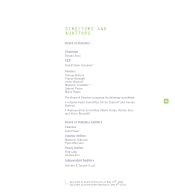Tiscali 2003 Annual Report Download - page 21
Download and view the complete annual report
Please find page 21 of the 2003 Tiscali annual report below. You can navigate through the pages in the report by either clicking on the pages listed below, or by using the keyword search tool below to find specific information within the annual report.
2222
Gross profit was up 25% on the previous year at EUR 455.1 million, or 51% of revenues (49% in 2002). The figure was boosted
by the substantial synergies generated by the Group’s extensive network infrastructure and falling traffic acquisition and line ren-
tal costs. The result is even more significant given the increasing contribution from the broadband business, which in the whole-
sale market is less profitable than narrowband access (see earlier section on the broadband market).
Tiscali expects operating costs as a proportion of revenues to fall further in 2004, as revenues rise, and general, administrative
and personnel costs remain broadly flat.
Operating costs break down as follows:
•marketing costs rose from EUR 122.8 million in 2002 (16% of revenues) to EUR 140 million at end-2003 (flat at 16%),
following significant investment related to the launch of broadband services;
• personnel costs increased from EUR 140.1 million in 2002 to EUR 142.1 million at end-2003 (declining from 19% to 16%
of revenues);
• G&A costs fell from EUR 100.9 million in 2002 to EUR 98.3 million at end-2003 (dropping from 13% to 11% of revenues).
Operating costs, at EUR 380.4 million, were up slightly on the previous year in absolute terms, but were down as a percentage of
revenues, from 49% to 42%.
EBITDA was positive at EUR 74.7 million, or 8.2% of revenues, a huge increase on the EUR 1 million recorded in 2002.
The Group made an EBIT loss of EUR 228.9 million, although this was a 43% improvement on the loss of EUR 399.8 million
posted the previous year.
Depreciation charges totalled EUR 95 million, while amortisation came to EUR 137.1 million, of which EUR 72 million related
to goodwill (consolidation difference).
EBIT benefited from:
• changes in estimates of the remaining useful life of goodwill (or of the consolidation difference item relating to goodwill and
shown under intangible assets), with the consequent extension of the amortisation period from five years (generally adopted
prior to 31.12.2002) to 12 years;
• harmonisation at Group level of depreciation rates for plant and equipment, particularly IP and Ethernet network equipment
(commercially known as routers and L3/L2 switches).
These changes reduced depreciation and amortisation by EUR 142 million, of which EUR 130 million relates to goodwill.
These structural changes, which led to the extension of the goodwill amortisation period, relate to the following specific circum-
stances:
• the current market conditions, both generally and in relation to specific regions, and market prospects. In addition, Tiscali
has consolidated its business in each country in which it has a presence, and has boosted profitability as a result;
• the results posted by Group companies and their prospects as indicated in the business plan, which project a further signi-
ficant improvement in the Group’s financial situation, including free cash flow generation in the short to medium term;
• completion of the restructuring process and optimisation of the Group structure;
























